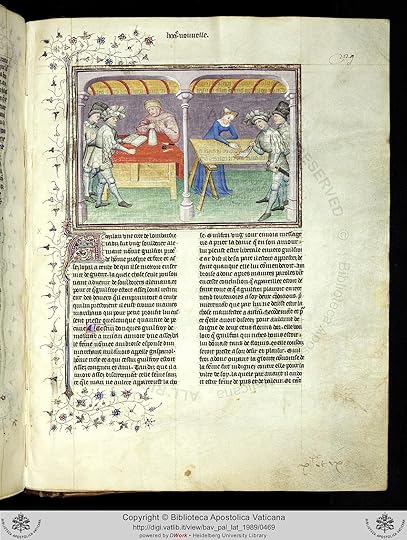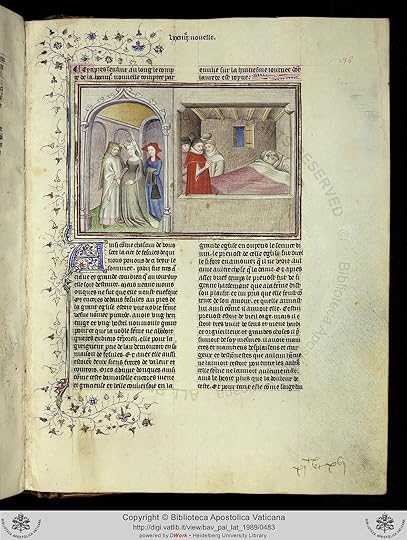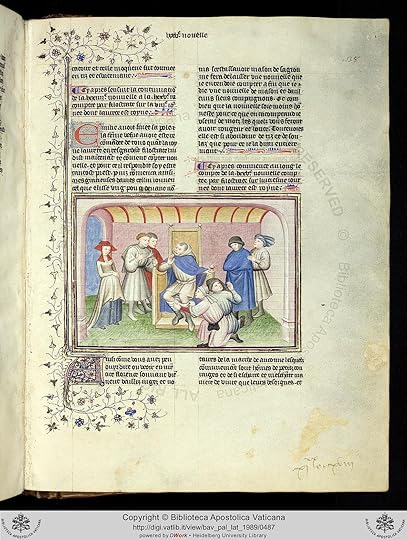Divine Comedy + Decameron discussion

This topic is about
The Decameron
Boccaccio's Decameron
>
9/8-9-14: Eighth Day, Introduction & Stories 1-5
date newest »
newest »
 newest »
newest »
message 1:
by
Kris
(new)
-
added it
Apr 14, 2014 09:33AM
 Mod
Mod
reply
|
flag
First tale (VIII, 1)
Neifile narrates. This tale (and the next one) comes from a thirteen-century French fabliau by Eustache d'Amiens. English speakers know it best from Chaucer's "The Shipman's Tale". Chaucer borrowed from the same fabliau as Boccaccio did.
The Shipman's Tale (also called The Sailor's Tale) is one of The Canterbury Tales by Geoffrey Chaucer.
It is in the form of a fabliau and tells the story of a miserly merchant, his avaricious wife and her lover, a wily monk. Although similar stories can be found in Boccaccio's Decameron, a frequent source for Chaucer's tales, the story is a retelling of a common folk tale; "the lover's gift regained".
Neifile narrates. This tale (and the next one) comes from a thirteen-century French fabliau by Eustache d'Amiens. English speakers know it best from Chaucer's "The Shipman's Tale". Chaucer borrowed from the same fabliau as Boccaccio did.
The Shipman's Tale (also called The Sailor's Tale) is one of The Canterbury Tales by Geoffrey Chaucer.
It is in the form of a fabliau and tells the story of a miserly merchant, his avaricious wife and her lover, a wily monk. Although similar stories can be found in Boccaccio's Decameron, a frequent source for Chaucer's tales, the story is a retelling of a common folk tale; "the lover's gift regained".
Third tale (VIII, 3)

Calandrino, Bruno and Buffalmacco go in quest of the heliotrope (bloodstone) beside the Mugnone
The mineral heliotrope, also known as bloodstone, is a form of chalcedony (which is a cryptocrystalline mixture of quartz and its monoclinic polymorph moganite). The "classic" bloodstone is green chalcedony with red inclusions of iron oxide or red jasper. Sometimes the inclusions are yellow, in which case the mineral is given the name plasma.
The red inclusions are supposed to resemble spots of blood; hence the name "bloodstone". The name "heliotrope" (from Greek ήλιος helios, Sun, τρέπειν trepein, to turn) derives from various ancient notions about the manner in which the mineral reflects light. These are described, e.g., by Pliny the Elder (Nat. Hist. 37.165). [1]
Heliotrope features in one of Boccaccio's stories in the Decameron.

Calandrino, Bruno and Buffalmacco go in quest of the heliotrope (bloodstone) beside the Mugnone
The mineral heliotrope, also known as bloodstone, is a form of chalcedony (which is a cryptocrystalline mixture of quartz and its monoclinic polymorph moganite). The "classic" bloodstone is green chalcedony with red inclusions of iron oxide or red jasper. Sometimes the inclusions are yellow, in which case the mineral is given the name plasma.
The red inclusions are supposed to resemble spots of blood; hence the name "bloodstone". The name "heliotrope" (from Greek ήλιος helios, Sun, τρέπειν trepein, to turn) derives from various ancient notions about the manner in which the mineral reflects light. These are described, e.g., by Pliny the Elder (Nat. Hist. 37.165). [1]
Heliotrope features in one of Boccaccio's stories in the Decameron.
Elissa narrates this tale, the first in which Bruno and Buffalmacco appear. The two were early Renaissance Italian painters. However, both are known far better for their love of practical jokes than for their artistic work. Boccaccio probably invented this tale himself, though, and used well known jokers as characters.

Buonamico di [son of] Martino or Buonamico Buffalmacco (active c. 1315–1336) was an Italian painter who worked in Florence, Bologna and Pisa. Although none of his known work has survived, he is widely assumed to be the painter of a most influential fresco cycle in the Camposanto in Pisa, featuring the The Three Dead and the Three Living, the Triumph of Death, the Last Judgement, the Hell, and the Thebais (several episodes from the lives of the Holy Fathers in the Desert). Painted some ten years before the Black Death spread over Europe in 1348, the cycle - a "painted sermon" (L. Bolzoni) - enjoyed an extraordinary success after that date, and was often imitated throughout Italy. The youngsters' party enjoying themselves in a beautiful garden while Death piles mounds of corpses all around is likely to have inspired the setting of Giovanni Boccaccio's Decameron, written a few years after the Black Death.


Buonamico di [son of] Martino or Buonamico Buffalmacco (active c. 1315–1336) was an Italian painter who worked in Florence, Bologna and Pisa. Although none of his known work has survived, he is widely assumed to be the painter of a most influential fresco cycle in the Camposanto in Pisa, featuring the The Three Dead and the Three Living, the Triumph of Death, the Last Judgement, the Hell, and the Thebais (several episodes from the lives of the Holy Fathers in the Desert). Painted some ten years before the Black Death spread over Europe in 1348, the cycle - a "painted sermon" (L. Bolzoni) - enjoyed an extraordinary success after that date, and was often imitated throughout Italy. The youngsters' party enjoying themselves in a beautiful garden while Death piles mounds of corpses all around is likely to have inspired the setting of Giovanni Boccaccio's Decameron, written a few years after the Black Death.

Fourth tale (VIII, 4)
Emilia's tale originates from the fabliau "Le Prestre et Alison" by Guillaume Le Normand
Emilia's tale originates from the fabliau "Le Prestre et Alison" by Guillaume Le Normand
Fifth tale (VIII, 5)
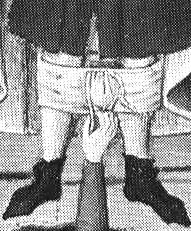
c1430-40 Stealing a judge's britches.
Everything you'll ever want to know about medieval underwear:
Sherts, Trewes, & Hose .i. :
A Survey of Medieval Underwear
http://www.greydragon.org/library/und...
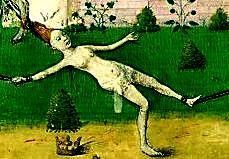
Boccaccio, ca 1475, of a woman prisoner wearing trewes.

c1430-40 Stealing a judge's britches.
Everything you'll ever want to know about medieval underwear:
Sherts, Trewes, & Hose .i. :
A Survey of Medieval Underwear
http://www.greydragon.org/library/und...

Boccaccio, ca 1475, of a woman prisoner wearing trewes.
 ReemK10 (Paper Pills) wrote: "The Shipman's Tale (also called The Sailor's Tale) is one of The Canterbury Tales by Geoffrey Chaucer."
ReemK10 (Paper Pills) wrote: "The Shipman's Tale (also called The Sailor's Tale) is one of The Canterbury Tales by Geoffrey Chaucer."Nice! I had the feeling that some of these stories were shared between these two books.
 Pfiou! We iz already in day 8?! O_o
Pfiou! We iz already in day 8?! O_oI'm just a leettle bit behind (somewhere in day 6 I think!). But that post on medieval underwear is making me very curious... ^^
 Illustrations - Day VIII Story 1
Illustrations - Day VIII Story 1
http://gallica.bnf.fr/ark:/12148/btv1...
Gulfardo payant Ambruogia

Source: gallica.bnf.fr
(view spoiler)
 Illustrations - Day VIII Story 2
Illustrations - Day VIII Story 2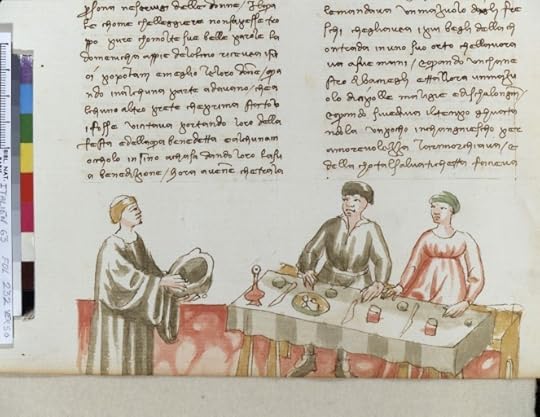
http://gallica.bnf.fr/ark:/12148/btv1...
Belcolore récupérant son mortier

Source: gallica.bnf.fr
(view spoiler)
 Illustrations - Day VIII Story 3
Illustrations - Day VIII Story 3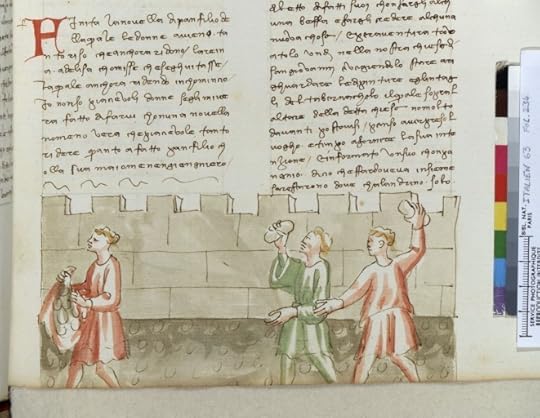
http://gallica.bnf.fr/ark:/12148/btv1...
Calandrino lapidé par ses amis
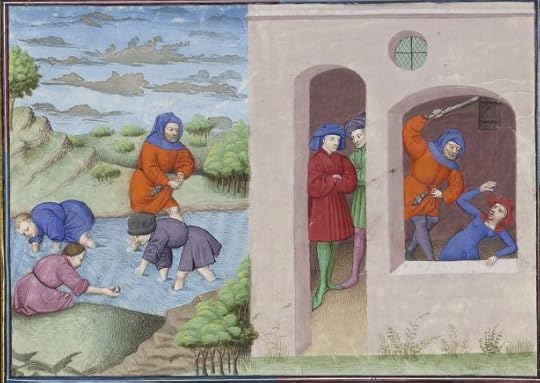
Source: gallica.bnf.fr
(view spoiler)
 Illustrations - Day VIII Story 4
Illustrations - Day VIII Story 4
http://gallica.bnf.fr/ark:/12148/btv1...
Punition du prévôt de Fiesole
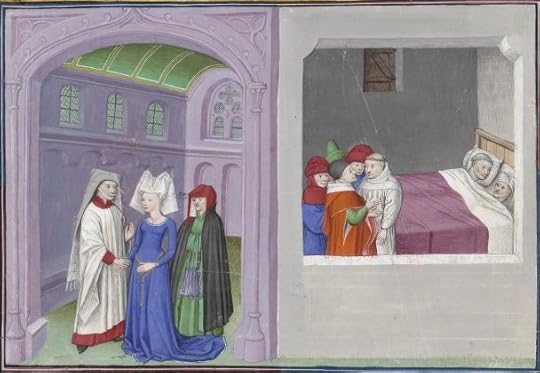
Source: gallica.bnf.fr
(view spoiler)
 Illustrations - Day VIII Story 5
Illustrations - Day VIII Story 5
http://gallica.bnf.fr/ark:/12148/btv1...
Maso del Saggio se moquant du juge

Source: gallica.bnf.fr
(view spoiler)
Book Portrait wrote: "Pfiou! We iz already in day 8?! O_o
I'm just a leettle bit behind (somewhere in day 6 I think!). But that post on medieval underwear is making me very curious... ^^"
BP, it is good that you checked in and posted your pics as I was getting worried about you. And you know you just wanted to learn more about medieval underwear! lol
I'm just a leettle bit behind (somewhere in day 6 I think!). But that post on medieval underwear is making me very curious... ^^"
BP, it is good that you checked in and posted your pics as I was getting worried about you. And you know you just wanted to learn more about medieval underwear! lol
 Linda wrote: "Thanks, BP! It wouldn´t be the same reading it without these! :)"
Linda wrote: "Thanks, BP! It wouldn´t be the same reading it without these! :)"Every little help to keep reading! :)
 ReemK10 (Paper Pills) wrote: "BP, it is good that you checked in and posted your pics as I was getting worried about you. And you know you just wanted to learn more about medieval underwear! lol"
ReemK10 (Paper Pills) wrote: "BP, it is good that you checked in and posted your pics as I was getting worried about you. And you know you just wanted to learn more about medieval underwear! lol"The hands stealing the underwear from under the table is just too much to resist! I'll have to catch up asap. :)
Yann wrote: "ReemK10 (Paper Pills) wrote: "The Shipman's Tale (also called The Sailor's Tale) is one of The Canterbury Tales by Geoffrey Chaucer."
Nice! I had the feeling that some of these stories were shared..."
Go figure Yann, “Chaucer Doth Tweet,” has now attracted an impressive 29,800 followers
https://twitter.com/LeVostreGC
Nice! I had the feeling that some of these stories were shared..."
Go figure Yann, “Chaucer Doth Tweet,” has now attracted an impressive 29,800 followers
https://twitter.com/LeVostreGC


